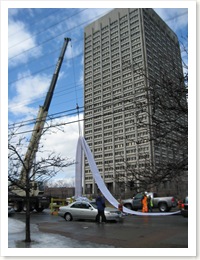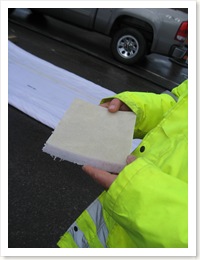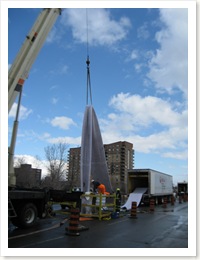Trenchless sewer pipe rehabilitation
 There has been a City of Ottawa crew working on Scott Street between Holland and Parkdale the last couple of days. Yesterday, it looked like they were cleaning the pipes and fussing one of the manholes. Today, they’ve erected a fence around the manhole and been using a crane to pull what looks like a piece of white cloth out of the back of a tractor trailer.
There has been a City of Ottawa crew working on Scott Street between Holland and Parkdale the last couple of days. Yesterday, it looked like they were cleaning the pipes and fussing one of the manholes. Today, they’ve erected a fence around the manhole and been using a crane to pull what looks like a piece of white cloth out of the back of a tractor trailer.
My co-workers and I were speculating about what they’re doing before lunch. Among the things we came up with included cleaning up after an oil spill or something to do with the Freon discharge from the heating plant in Tunney’s Pasture last week.
I headed out at lunch and on the way back to the office I checked out the worksite and got the lowdown on it from the crew.
 It turns out that they are doing what’s called trenchless sewer pipe rehabilitation. Basically, they insert a sleeve into the pipe, force it through the pipe with hot water, wait for it to set and then cut the holes where the pipes from houses connect to it.
It turns out that they are doing what’s called trenchless sewer pipe rehabilitation. Basically, they insert a sleeve into the pipe, force it through the pipe with hot water, wait for it to set and then cut the holes where the pipes from houses connect to it.
The white material they’re pulling with the crane is actually an inside-out tube. They attach one end at the mouth of the pipe and force hot water in the “cuff”. This causes the tube to turn rightside-out as the pressure forces the tube along.
The hot water also causes the material, which I believe he said was styrene, to harden. The result is a fairly rigid pipe lining that doesn’t have any seams and is rated to last at least 50 years.
The supervisor had a piece of the material, which was most of an inch thick. One side (the inside) was much smoother than the other. He said he’s replaced dozens of kilometres of pipes in Ottawa over the years using this technique. When he’s gone back to inspect some of the early jobs they look like they were just replaced.
 The time and money savings are incredible. He said this job, which is seeing the replacement of a couple of hundred metres of pipe, is going to take three days. The first day they clean the pipe, inspect it for caved-in sections and remove the rungs of the ladder in the manhole. Day Two sees them doing the actual replacement and Day Three sees a final post-installation inspection and re-installation of the ladder rungs. He said if they had to replace the pipe using the conventional technique of digging up the street this three-day job would become a six-week job and be much more costly because there would be more people involved and the gas required to operate all the machinery would be quite significant.
The time and money savings are incredible. He said this job, which is seeing the replacement of a couple of hundred metres of pipe, is going to take three days. The first day they clean the pipe, inspect it for caved-in sections and remove the rungs of the ladder in the manhole. Day Two sees them doing the actual replacement and Day Three sees a final post-installation inspection and re-installation of the ladder rungs. He said if they had to replace the pipe using the conventional technique of digging up the street this three-day job would become a six-week job and be much more costly because there would be more people involved and the gas required to operate all the machinery would be quite significant.
I was really impressed that he was willing to talk to me and someone else who was curious about what they’re doing. He must get a lot of people stopping to ask questions when they’re doing this because he had the sample of the pipe liner to talk about. Definitely the kind of person the City wants talking to the public!
You can read about trenchless pipe rehabilitation on the City of Ottawa’s website, where you’ll also find a video that describes the process in more detail. The video is definitely worth checking out.



 AKA Keeper of Maps, I'm a geocacher who lives in Ottawa, Canada.
AKA Keeper of Maps, I'm a geocacher who lives in Ottawa, Canada.

Now THTAT is cool!!! Sort of like an internal cast for the old rusting pipes. I haven’t gone off yet to read the other links, but I wonder how well it holds up against collapse and such.
Very cool way to re-work the pipes though.
The technology has been around for about 35 years, so it must be comparable to a standard pipe. It might even be more resilient since it’s probably not as brittle a material as concrete, but that’s just a guess.
The only question I have is when the 50 years is done, and the styrene is due to be replaced, how do they do that? Do they scrape it out, dispose of it, and then put new stuff in? What happens to the disposed material? Or does it break down over the years and get deposited into our water table?
It\’s interesting to see that they have an alternative to ripping up the street, but I\’d want more info to conclude that is this is a less expensive and more efficient process.
According to the supervisor the difference in cost is huge. The savings in the amount of fuel required to run the equipment alone is significant. And tearing up the road is enormously expensive. Extending the lifespan of a pipe this way is extremely cost-effective. There were only about 5 or 6 guys doing the work as opposed to the small army that’s required to dig up a road.
When this pipe is due to replacement, I imagine they will either insert another layer, reducing the inner diameter by about 2 more inches or they’ll have to replace the whole pipe. Eventually, however, the pipe will have to come out of the ground, at which point all the materials would be recovered and recycled.